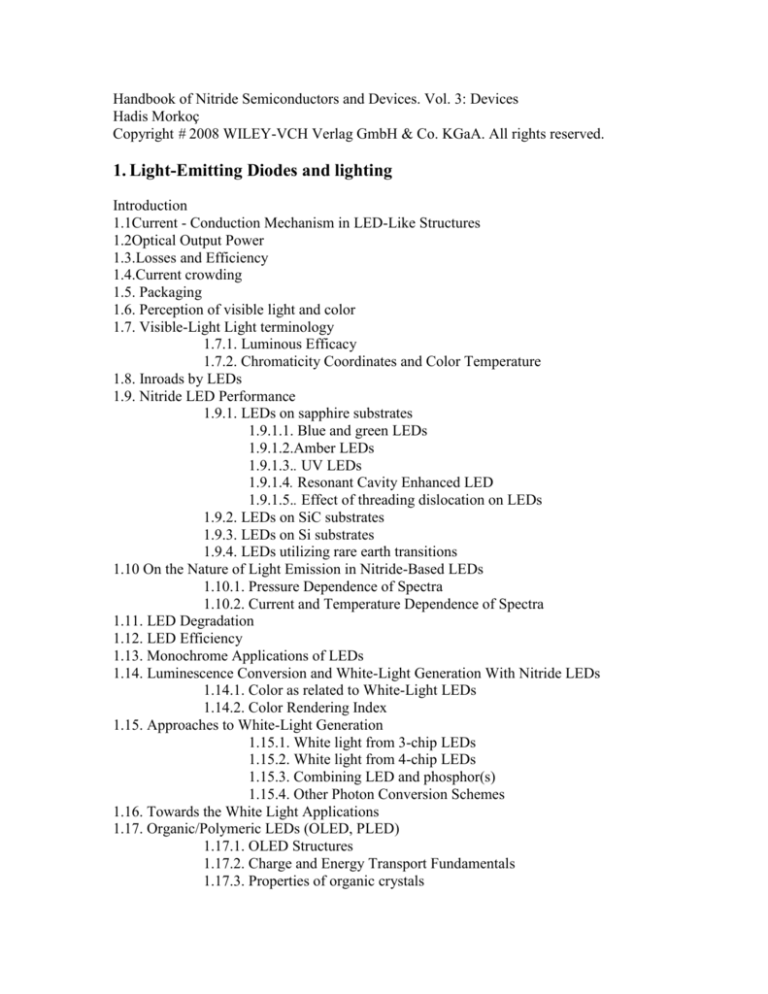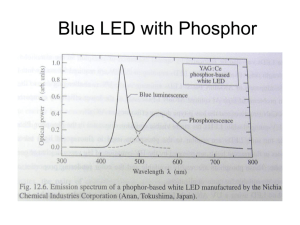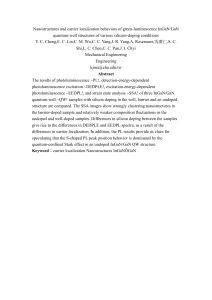
Handbook of Nitride Semiconductors and Devices. Vol. 3: Devices
Hadis Morkoç
Copyright # 2008 WILEY-VCH Verlag GmbH & Co. KGaA. All rights reserved.
1. Light-Emitting Diodes and lighting
Introduction
1.1Current - Conduction Mechanism in LED-Like Structures
1.2Optical Output Power
1.3.Losses and Efficiency
1.4.Current crowding
1.5. Packaging
1.6. Perception of visible light and color
1.7. Visible-Light Light terminology
1.7.1. Luminous Efficacy
1.7.2. Chromaticity Coordinates and Color Temperature
1.8. Inroads by LEDs
1.9. Nitride LED Performance
1.9.1. LEDs on sapphire substrates
1.9.1.1. Blue and green LEDs
1.9.1.2.Amber LEDs
1.9.1.3.. UV LEDs
1.9.1.4. Resonant Cavity Enhanced LED
1.9.1.5.. Effect of threading dislocation on LEDs
1.9.2. LEDs on SiC substrates
1.9.3. LEDs on Si substrates
1.9.4. LEDs utilizing rare earth transitions
1.10 On the Nature of Light Emission in Nitride-Based LEDs
1.10.1. Pressure Dependence of Spectra
1.10.2. Current and Temperature Dependence of Spectra
1.11. LED Degradation
1.12. LED Efficiency
1.13. Monochrome Applications of LEDs
1.14. Luminescence Conversion and White-Light Generation With Nitride LEDs
1.14.1. Color as related to White-Light LEDs
1.14.2. Color Rendering Index
1.15. Approaches to White-Light Generation
1.15.1. White light from 3-chip LEDs
1.15.2. White light from 4-chip LEDs
1.15.3. Combining LED and phosphor(s)
1.15.4. Other Photon Conversion Schemes
1.16. Towards the White Light Applications
1.17. Organic/Polymeric LEDs (OLED, PLED)
1.17.1. OLED Structures
1.17.2. Charge and Energy Transport Fundamentals
1.17.3. Properties of organic crystals
1.17.4. Light Emission Dynamics
1.17.4.1. Nonradiative recombination
1.17.4.2. Internal conversion
1.17.4.3. Inter-system crossing
1.17.4.4 Singlet fission
1.17.4.5. Aggregation and Davydov splitting
1.17.4.6. -Charge transfer excitons
1.17.5 OLED Devices
1.17.5.1. White OLEDs (WOLEDs)
1.17.5.2. Displays
1.17.6. Lighting with OLEDs
References
2. Semiconductor Lasers
2.1 Introduction
2.2. A Primer to the Principles of Lasers
2.3. Waveguiding
2.3.1. Refractive index of GaN and AlGaN
2.3.2. Refractive index of InGaN
2.3.3. Analytical Solution to the Waveguide Problem
2.3.4. Numerical Solution to the Waveguide Problem
2.3.5. Far Field Pattern
2.4. Loss, Threshold, and Cavity Modes
2.5. Optical Gain
2.5.1. A Glossary for Semiconductor Lasers
2.5.2. Optical Gain in Bulk Layers: A Semiconductor Approach
2.5.2.1. Relating Absorption Rate to Absorption Coefficient
2.5.2.2. Relating Stimulated Emission Rate to Absorption Coefficient
2.5.2.3. Relating Spontaneous Emission Rate to Absorption Coefficient
2.5.2.4. Fermi’s Golden Rule, Stimulated and Spontaneous Emission
Rates, and Absorption Coefficient Within the k-Selection Rule.
2.5.3. Gain in Quantum Wells
2.6. Coulombic Effects
2.7. Numerical Gain Calculations for GaN
2.7.1. Optical Gain in Bulk GaN
2.7.2. Gain in GaN Quantum Wells
2.7.3. Gain Calculations in Wz GaN QWells Without Strain
2.7.4. Gain Calculations in Wz QWells With Strain
2.7.5. Gain in ZB QWells Structures Without Strain
2.7.6. Gain in ZB QWells Structures With Strain
2.7.6.1. Pathways Through Excitons and Localized States
2.7.6.1.1. Excitons
2.7.6.1.2. Localized States
2.7.7 Measurement of Gain in Nitride Lasers
2.7.7.1. Gain Measurement via Optical Pumping
2.7.7.2. Gain Measurement via Electrical Injection (Pump) and Optical
Probe Method
2.8. Threshold Current
2.9. Analysis of Injection Lasers with Simplifying Assumptions
2.10. Recombination Lifetime
2.11. Quantum Efficiency
2.12. GaN Based LD Design and Performance
2.13. Gain Spectra of InGaN Injection Lasers
2.14. Near UV lasers
2.15. Reflector Stacks and Vertical Cavity Surface Emitting Lasers (VCSELs)
2.16. Polariton Lasers
2.17. GaInAsN Quaternary Infrared Based Lasers
2.18. Laser Degradation
2.19. Application of GaN Based Lasers to DVDs
2.20. A Succinct Review of the Laser Evolution in Nitrides
References
3. Field Effect Transistors and Heterojunction Bipolar Transistors
3.1 Heterojunction Field Effect Transistors (HFETs)
3.1.1. Electron transport properties in GaN and GaN/AlGaN heterostructures
3.1.2.Heterointerface charge
3.1.3.Electromechanical coupling
3.1.4.Analytical description of HFETs
3.1.4.1. Examples for GaN and InGaN channel HFETs
3.1.4.1.1. The case of Al0.2 Ga0.8 N / GaN
3.1.4.1.2. The case of Al0.2 Ga0.8 N / In0.1Ga0.9 N
3.1.4.1.3. The case of InAlN / GaN
3.1.4.1.4. The case of InAlN / InGaN
3.1.5. Numerical modeling of sheet charge and current
3.1.6. Numerically Calculated I-V Characteristics
3.2. The s-parameters and gain
3.3. Equivalent circuit models, de-embedding and cut off frequency
3.3.1. Small Signal Equivalent Circuit Modeling
3.3.2. Large signal equivalent circuit modeling
3.3.2.1.Non-linearities
3.3.2.2. Dispersion and Temperature Effects
3.3.3. Cut off Frequency
3.4.HFET Amplifier Classification and Efficiency
3.5.AlGaN/GaN HFETs
3.5.1.Experimental Performance of GaN FETs
3.5.2 Power amplifiers (PA) and Low Noise Amplifiers (LNA)
3.5.3 Drain Voltage and Drain Breakdown Mechanisms
3.5.4 Field Plate For Spreading Electric Field to Increase Breakdown Voltage
3.5.5 Anomalies in GaN MESFETs and AlGaN/GaN HFETs
3.5.5.1. Effect of the Traps in the Buffer Layer
3.5.5.2. Effect of Barrier States
3.5.5.3 Field Assisted Emission from the Barrier Traps
3.5.5.4. Defect Mapping by Kelvin Probe and Effect of Surface States
3.5.5.4.1. Drain Current Transients
3.5.5.4.2. Surface Potential Transients
3.5.5.4.3. Correlation Between Current Collapse and Surface Charging
3.6. Electronic noise
3.6.1. Shot noise
3.6.2. Generation-Recombination Noise
3.6.3. Thermal noise
3.6.4. Avalanche noise
3.6.5. Low frequency noise (1/f noise)
3.6.5.1. Non- fundamental 1/f noise
3.6.5.2.Fundamental 1/f noise
3.6.6. High Frequency Noise
3.6.7. Treatment of Noise with FET Equivalent Circuit
3.6.8. 1/f noise in Conjunction with GaN FETs
3.6.9. High Frequency Noise in Conjunction with GaN FETs
3.7. Dielectrics for Passivation Purposes or Gate Leakage Reduction
3.8. Heat Dissipation and Junction Temperature
3.9. Hot Phonon Effects
3.9.1. Phonon Decay Channels and Decay Time
3.9.2.Implications for FETs
3.10.InGaN Channel and or InAlN Barrier HFETs
3.11. FET degradation
3.11.1. Reliability Measurements
3.11.2. GaN HFET Reliability
3.11.2.1. Gate Current
3.11.2.2.Metallurgical Issues
3.11.2.3. Hot electron and Hot Phonon Issues
3.11.2.4. Other Reliability Issues
3.12. Heterojunction Bipolar Transistors (HBTs)
3.12.1. HBT Fundamentals
3.12.1.1. Current Transport Mechanism Across the Heterojunction
3.12.1.2. Current Transport Mechanism Across the Base
3.12.1.3. Electron velocity overshoot in the collector space charge region
3.12.1.4. Current Gain and Recombination Current of HBTs
3.12.1.5. Current Gain at High Currents
3.12.1.6. Emitter Current Crowding Effect
3.12.1.7. Noise in Bipolar Transistors
3.12.2. Nitride Based HBTs
3.13 Concluding Comments
Appendix: Sheet charge calculation in AlGaN/GaN structures with AlN interface layer
(AlGaN/AlN/GaN)
References
Chapter 4 Ultraviolet Detectors
Table of Contents
4.1. Introduction
4.2.Principles of Photodetectors
.4.2.1. Current and Voltage Response to Incident Radiation
4.2.1.1.Photoconductive Detectors
4.2.1.2.p-n Junction Photovoltaic Detectors
4.2.1.2.1.Diffusion Current for a p-n Junction Detector
4.2.1.2.2.Space-Charge Current in a p-n Junction Detector
4.2.1.2.3.Generation-Recombination Current
4.2.1.2.4.Tunneling Current
4.2.1.2.5.Surface Leakage Current
4.2.2.Noise in detectors
4.2.2.1.Thermal Noise
4.2.2..2. Shot Noise
4.2.2..3.Generation-Recombination Noise
4.2.2..4. 1/f Noise
4.2.3. Quantum Efficiency
4.2.3.1.Quantum Efficiency in Photoconductors
4.2.3. 2.Quantum Efficiency in a p-n Junction Detector
4.2.4.Responsivity
4.2.5. Signal to Noise Ratio, Noise Equivalent Power and Detectivity
4.2.5.1.Thermal Limited
4.2.5.2. Shot Current Limited
4.2.5.3. Generation Recombination Limited
4.2.5.4. Background Limited
4.2.5.5. Noise in a p-n Junction Detector
4.2.5.6. Detectivity for a p-n Junction Detector
4.2.6. Surface and Bulk Recombination in Detectors
4.3. Particulars of Deep UV Radiation and Detection
4.3.1. Solar UV Radiation
4.3.2. Stratospheric Ozone and UV Absorption
4.3.3. Computational Method Called Plexus
4.3.4. UV Transmission of the Atmosphere
4.3.5. Number of Solar UV Photons Reaching Lower Altitudes
4.3.6. Atmospheric Detection Range
4.3.7. Inevitable and Unavoidable Losses of Photons
4.3.8. Practical UV Sensor Detection Ranges
4.3.9. Available UV Sensors
4.3.10. Design Requirements for UV Solar Blind Imaging Detectors
4.4 Si and SiC Based UV Detectors
4.4.1.Silicon based UV photodetectors
4.4.2. Silicon Based UV Photodetectors
4.5. Nitride Based Detectors
4.5.1. Photoconductive Detectors
4.5.2. Photovoltaic Detectors and Junction Detectors
4.5.2.1.GaN and AlGaN- Based Schottky Barrier Photodiodes
4.5.2.2. Metal Semiconductor Metal (MSM) Detectors
4.5.2.3. p-n and p-i-n Junction Detectors
4.5.2.3.1. Noise Under Reverse Bias
4.5.2.3.2. Noise Measurements Under Forward Bias
4.5.2.3.3. Noise Measurements Under Illumination
4.5.2.4. AlGaN/GaN Heterojunction Detectors
4.5.2.5. AlGaN Detectors Including the Solar Blind Variety
4.5.2.6. AlGaN/GaN MQW Photodetectors
4.5.2.7. Heterojunction Phototransistors
4.5.2.8. Avalanche Photodetectors
4.6. UV Imagers
4.7. Concluding comments
References







